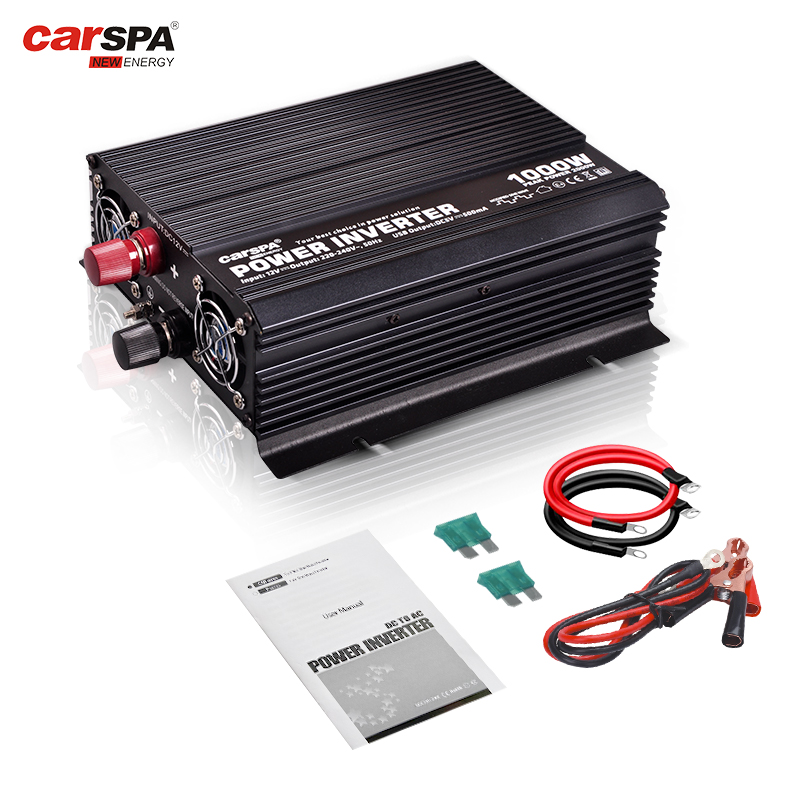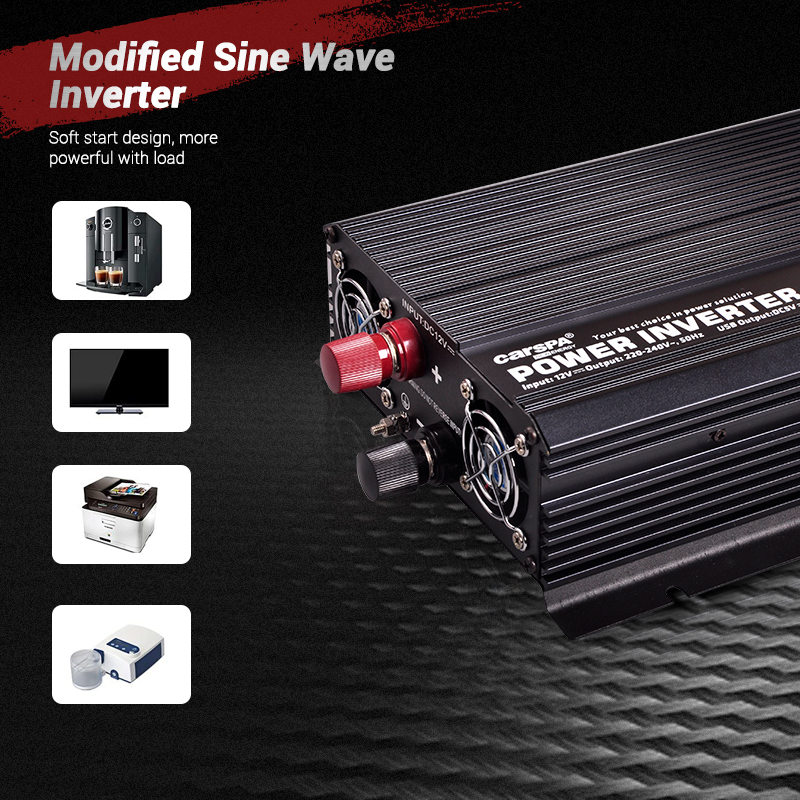What size inverter do I need for a house or a car?
As people's demand for electricity continues to increase, inverters play an important role in home and car applications. It can convert direct current power (DC) such as batteries into alternating current (AC) to meet the various needs for electricity in daily life. Whether it is to deal with sudden power outages in the home or to provide power for various devices in the car, the inverter plays an irreplaceable role. 1000W inverter has become one of the first choices for many home and car users because of its moderate power and wide range of uses. In this article, we will discuss in detail the issues that need to be paid attention to when choosing an inverter suitable for home or car use.
What is an inverter? How does it work?
An inverter is an electronic device that converts direct current (DC) into alternating current (AC). Since most home and car electrical equipment uses AC power, and batteries and solar panels usually generate DC power, the role of the inverter is to convert these DC power sources into AC power that can be used by electrical appliances. Its working principle is mainly to achieve the continuous switching of the direction of DC current through high-frequency switching technology and filters to generate AC current.
Different types of inverters will output different voltage waveforms, including sine waves, square waves, and modified waves. The waveform produced by the sine wave inverter is closest to the AC power waveform, which is very suitable for power-sensitive devices such as computers, TVs, and stereos. Modified wave or square wave inverters are suitable for appliances that do not require high voltage waveforms, such as electric fans and lights.
1000W inverter is a common type of inverter, suitable for electrical appliances with low power supply. Its rated power is 1000W, which is enough to power multiple small and medium-sized devices at the same time, such as TVs, laptops, car refrigerators, and lighting equipment. In addition, it has strong adaptability and can adapt to household power or car power, and is widely used in various scenarios such as home, car, and outdoor.
How much power inverter is needed for home use? Is a 1000W inverter enough?
When choosing a home inverter, you first need to determine the power of the inverter based on the power requirements of commonly used appliances in the home. Common electrical appliances in the home include refrigerators, TVs, air conditioners, microwave ovens, washing machines, etc. The power requirements of these devices vary greatly. Here is a list of the power ranges of some common household appliances:
Lighting: 60-100 watts
TV: 100-300 watts
Refrigerator: 400-800 watts
Laptop: 50-100 watts
Microwave: 800-1500 watts
Washing machine: 500-1200 watts
Air conditioner: 1000 watts and above
Suppose we need to power the refrigerator, TV and lighting in the home during a power outage, and the total power demand is 600 watts (refrigerator) + 150 watts (TV) + 80 watts (lighting) = 830 watts. In this case, a 1000W power inverter is a suitable choice to stably power these devices. In addition, a 1000W inverter also has a certain power redundancy to cope with the power surge problem when the appliance starts.
However, if the total power of the devices running at the same time exceeds 1000W, such as a refrigerator, microwave oven and washing machine running at the same time, then a 1000W inverter may not be able to meet the demand. At this time, you may need to choose a higher power inverter, such as a 1500W or 2000W model. Therefore, when choosing a home inverter, it is very important to understand the total power requirements of the electrical equipment in the home and choose the appropriate inverter model.
How much power inverter is needed for car use? Is a 1000W inverter suitable?
Inverters are also widely used in cars, especially when traveling long distances or camping, car inverters can provide power for a variety of devices. Common car devices include laptops, car refrigerators, lighting equipment, mobile phone chargers, etc. Compared with homes, the power of electrical equipment in cars is usually smaller, so a 1000W car inverter is sufficient to meet the needs in most cases.
Here are some common car-mounted devices' power requirements:
Mobile phone charger: 10-20 watts
Laptop: 50-100 watts
Car refrigerator: 60-100 watts
Portable TV: 50-150 watts
Small electric fan: 30-50 watts
Assuming that a laptop, car refrigerator and mobile phone charger are running in the car at the same time, the total power is 100 watts (laptop) + 80 watts (car refrigerator) + 20 watts (mobile phone charger) = 200 watts. A 1000W inverter can fully cope with the operation of these devices, and even has sufficient power margin.
However, it should be noted that if you use higher-power appliances in the car, such as car electric stoves, microwave ovens, etc., you may need to choose a higher-power inverter. Generally speaking, a 1000W inverter is suitable for most car-mounted devices, but if you need to run high-power devices or use multiple devices at the same time, you may need to consider a higher-power model.
In addition, when using an inverter in a car, you should also pay attention to the battery capacity and generator capacity of the vehicle. Long-term operation of high-power devices may quickly drain the battery. It is recommended to start the car engine when the vehicle-mounted device is used for a long time to avoid the situation where the battery is exhausted and the car cannot start.
How long can a 1000W inverter run continuously?
The operating time of the inverter mainly depends on the capacity of the connected battery and the power demand of the connected device. Common battery specifications include 12V and 24V batteries, and the capacity of the battery is measured in ampere hours (Ah). The runtime of the inverter can be calculated by the following formula:
Runtime = Battery capacity (Ah) × Battery voltage (V) × Inverter efficiency / Total device power
For example, assuming a 12V 100Ah battery is used, and the inverter efficiency is 90%, and the total power of the connected devices is 1000W, the runtime is calculated as follows:
Runtime = 100Ah × 12V × 90% / 1000W = 1.08 hours
This means that a 12V 100Ah battery can provide continuous power to a 1000W inverter for about 1 hour. If a larger capacity battery is used, such as a 12V 200Ah, the runtime will double to about 2 hours.
In addition, the power demand of the appliance will also affect the runtime. If the connected device has a lower power, the inverter runtime will be extended accordingly. For example, if a 1000W inverter is used to power a 300W device, the same 100Ah battery can support longer use.
Choose the right inverter brand and model
When choosing an inverter, in addition to power, peak power and battery capacity, you also need to pay attention to the choice of brand and model. Inverters from high-quality brands usually have higher efficiency and longer service life, and have multiple protection functions, such as overload protection, short circuit protection and overheating protection.
There are many well-known inverter brands on the market, and CARSPA is a trustworthy brand. CARSPA offers inverters in a variety of power ranges, and its 1000W inverter has been widely praised by users for its efficient energy conversion, stable power output and multiple protection functions. Whether in a home environment or in a car, CARSPA inverters can provide users with reliable power solutions.
Conclusion
The 1000-watt power inverter is a very suitable device for home and car use, which can provide stable power support for a variety of electrical devices. Whether it is to deal with sudden power outages at home or to provide power for mobile devices during car travel, the 1000W inverter can meet most power needs.
When choosing an inverter, users should consider the power requirements of the device, the rated power and peak power of the inverter, and the actual usage scenario. At the same time, choosing an inverter from a high-quality brand can provide users with higher safety and usage experience. By correctly configuring the battery capacity and reasonably evaluating the power of the device, a 1000W inverter can not only serve as a backup power source at home, but also provide reliable power support for a variety of devices in the car, greatly improving the convenience of life.







